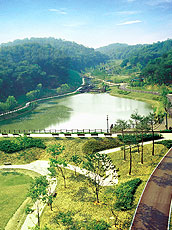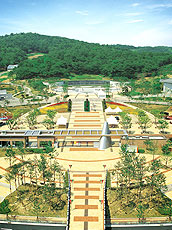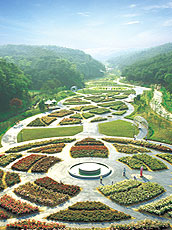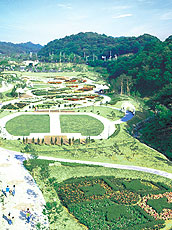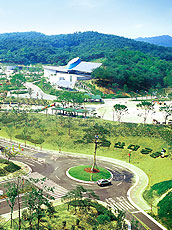Summary
A company driven by values
The history of SK forest goes back to 1972,
when the late Choi Jong-hyeon,
the inaugural chairman, expressed his belief that
'growing trees is to love your country.'

SK forest has been building up a plantation site spanning over 4,000 ha across Chungju, Cheonan, Yeongdong and etc. over the past four decades. The afforestation business has not only allowed the company to contribute to making the country greener, but the revenue from the business has also been used to fund scholarships. The late Chairman Choi’s contributions to the progress in developing the nation’s forests and building up forestry resources through SK forest were recognized by the Korean government, with his name being listed and commemorated in the 'Forest Hall of Fame' of the Korea National Arboretum in April, 2010. The plantation sites in Chungju, Cheonan and Yeongdong are the only 'Special District for Forestry Projects' designated by the Korea Forest Service as sites consisting of broad-leaved trees play a critical role by the private sector in the government’s efforts to grow forest areas.
Story of the SK FOREST
1.The founding of SK forest
SK Forest Co. Ltd. (formerly known as Seohae Development Co. Ltd.) was established in the early 1970s by SK Group (known as Sunkyung Group at the time) to set up a model for more comprehensive development such as building cultivation sites for fruit trees, farming on reclaimed land and tourism as an attempt to diversify its business portfolio that would not only generate returns in the field of agriculture, but also contribute to an increase in income for local residents. However, the constraints posed by the government’s land policy at the time proved to be challenging, prompting the late chairman Choi Jong-hyeon to switch gears and focus only on the afforestation business. He secured plots of land in the rural, mountainous areas, and carefully selected breeds from home and abroad to be planted. This became one of the first moves by a private corporation to form forests in the country. Italso represents the humble beginnings of SK forest, with only two employees and a small desk parked in the corner of another company’s office. Despite the initial challenges, it was their passion for forestry that eventually led to the growth of SK forest that we see today.
2.Purpose of Establishment
At the time of the company’s founding, the goal was to:
1. Secure 30,000ha of land
2. Lumber across 1,000ha of the site per year after 30 years
3. Finance the Korea Foundation for Advanced Studies with the revenue from the lumbering business.
The ultimate goal of the business has always been in line with what had been outlined by former Chairman Choi: help foster talent that would contribute to progress made in academia and industry by offering full scholarships to outstanding students for an opportunity to study abroad.
3.Securing the land
The basic approach taken by former Chairman Choi was to build an afforestation business run by a private company to convert the barren mountains of Korea into one rich in forestry resources that would bring economic benefits to the nation and also contribute to improved income for villagers in rural areas. One of the conditions that he set forth in achieving this goal was to purchase barren land in rural mountainous areas that were considered to have very little economic value at the time.
One of the reasons he focused on “land with little economic value” was because he believed in the potential of maximizing return by converting them into thick forest areas. The reason he focused on rural mountainous areas was because he wanted to avoid any misunderstanding that the initiative had speculative purposes as is often the case when corporate investments are made in land near metropolitan area. There was also the risk of areas close to the capital being designated as sites to be developed into cities or industrial complexes at a later date.
Secured mountainous areas in the Cheonan district from 1973 to 1978(480.9ha)

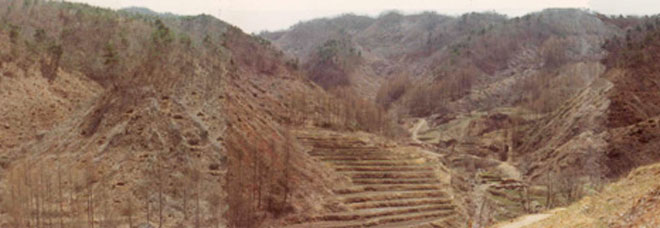
Cheonan District at the time of purchase

After reforestation of the Cheonan District

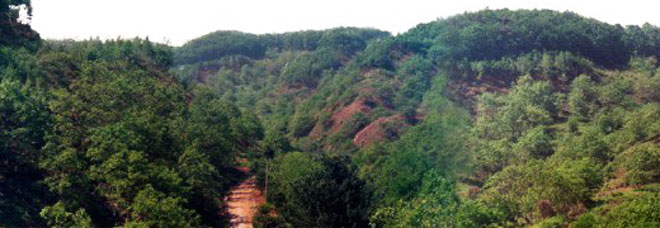
Secured land in the Chungju District in 1974 (1,180.1ha)

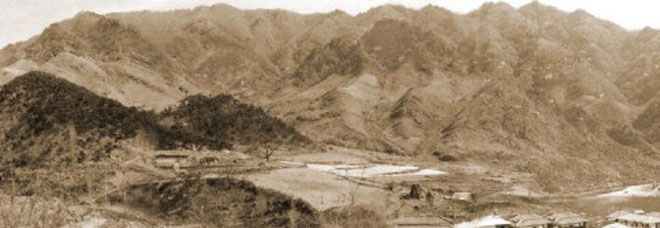
Chungju District at the time of purchase

After afforestation of the Chungju District

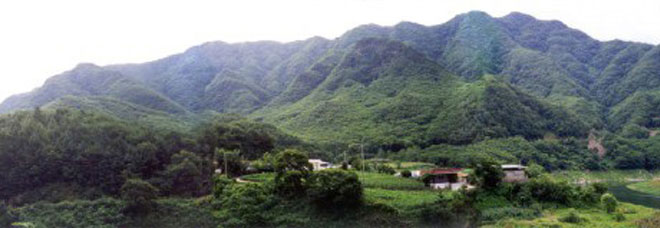
Secured land in the Yeongdong District from 1979 to 1986 (2,364.8ha)

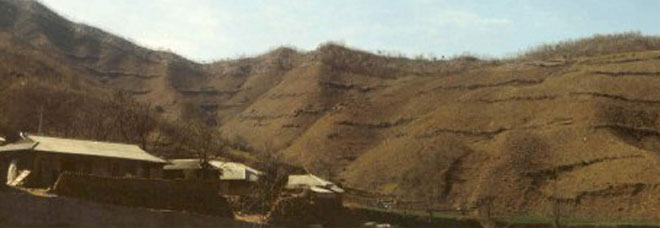
Yeongdong District at the time of purchase

After afforestation of the Yeongdong District

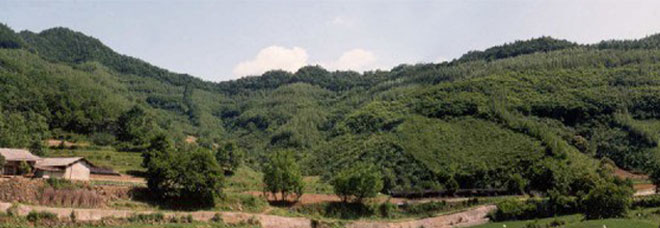
4.Preparing for Afforestation
While SK forest was working on securing the land to build its plantation site and carefully selecting the breeds of trees for afforestation, the Korea Forest Service set its own goal of converting barren mountainous areas across the nation completely into green areas. During the first stage of this governmental initiative (from 1973 to 1978), the Forest Service selected fruit trees, special purpose trees, and trees with long lives
Following this guidance, SK forest selected the walnut tree among the fruit trees that were recommended, due to the wide range of applications for its wood and the walnut’s popularity as a healthy food.
However, given the terrain and geographic location of the sites, the company concluded that it would be difficult to follow government guidance for the categories of special purpose trees and trees with long lives. Instead, SK forest opted for broad-leaved breeds which had not been considered by anyone else in Korea thus far. Specifically, two home-grown breeds were chosen: manchurian walnut, traditionally used as a material for instruments or buttstock on rifles, and the birch tree, which is often used to manufacture plywood or pulp, thanks to its dense structure and clean color conducive to further whitening.
For imported breeds, the black walnut tree originating from the U.S. which is used as a premium material for high-end furniture and pianos, was chosen. The fruit is also considered a healthy food, making the breed all the more appealing. The adoption of such broad-leaved trees was a drastic move away from the conventional afforestation projects at the time, which had focused on needle-leaf trees, and drew quite some attention from both industry and academia.
-
Manchurian walnut
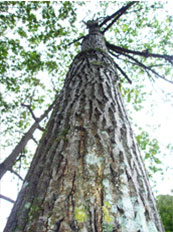
-
Birch tree
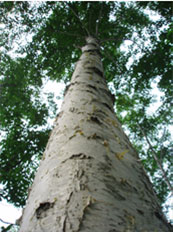
-
Walnut tree
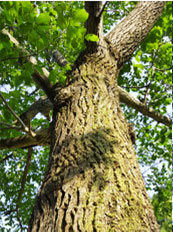
-
Fruit from the walnut tree
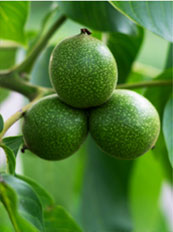
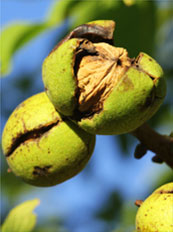
5.Designation as a special development area and establishment of a business plan
Before starting the afforestation projects in earnest, the company established a mid to long-term business management plan and on-site survey in accordance with the Forest Development Act for more efficient and sustainable development. To ensure that tree varieties that best fit the soil of a given area are planted, a survey on the soil was carried out jointly with the Division of Soil Surveys at the Forest Resource Survey Institute. Based on the survey findings, a 30-year plan for special development and management was established. However, due to the lack of specialists in forest development with relevant experience or any format that could be referenced, this was followed by a great deal of trial and error. Eventually, the plan was submitted to the Korea Forest Service in October of the same year. The Korea Forest Service, following its preliminary review of the plan, referred it to the review committee consisting of members from the Ministry of Agriculture, Ministry of Construction and the Economic Planning Agency, for a second round of reviews. On December 6, 1974, the areas in Chungju, Cheonan and Yeongdong were finally designated as 'special development areas,' and the green light was given to start the forest development projects in earnest.
6.Afforestation
SK forest started the afforestation project of the mountainous areas in Chungju, Cheonan and Yeongdong that it had secured, in accordance with the company’s mid to long-term program for forest management. On the Chungju plantation site (1,180.1 ha), birch trees and deciduous trees were planted, while the Cheonan plantation site (480.9 ha) saw 34,000 walnut trees and 323,000 birch trees being planted, laying the groundwork for a complex specializing in the growing of walnut trees. This led to SK forest being designated an “independent afforestation company” by the Korea Forest Service in November, 1976. Also, a large scale of birch trees were being planted in the Yeongdong plantation site (2,364.8 ha). The total aggregate 4,100 ha of land where SK forest planted trees is equivalent to 40 times the size of the area covered by Namsan (Nam Mountain) in Seoul (which is approximately 100h a), which shows the grand scale of the project undertaken by the company to contribute to the afforestation of the country.

崔鍾賢 像 (1929~1998)
Choi Jong-hyeon was a visionary for corporate afforestation, an area that he had deep passion for.
With the belief that “those who love their country plant trees,” the late chairman opened the first chapters of corporate afforestation in Korea by planting three million special purpose broad-leaved trees across an area of 4,000 ha in mountainous areas, starting in 1972.
He also donated 1,000 ha of plantation site to Chungnam University for further R&D in forestry studies. His will also included specific instructions to cremate his body after passing and also to construct and donate proper cremation facilities for the public, which also contributed to the preservation of forests.
(Commemoration in the Forest Hall of Fame in April, 2010)
7.Efforts to secure investment for afforestation
One of the biggest challenges in forming and managing large-scale forests and tree plantation sites was securing enough funding. There was a desperate need for investments that would help secure sufficient land, but in the early stages, there were no revenue streams. This meant that the company had to use its existing assets at the time to generate investment. To that end, for-profit initiatives were pushed forward in line with two principles: land already owned by the company would be more proactively used to generate profit, and the very raison d’etre of the company for corporate afforestation would not be undermined.
-
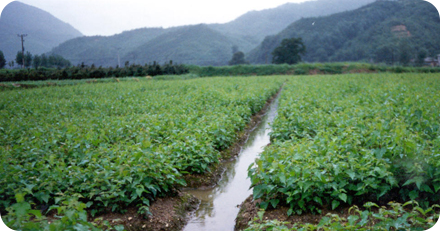
Business of
cultivating
saplingsOne of the first for-profit projects was to establish a production and distribution system using a pprox. 165,289m2 of land at the Osan site, where five species of saplings for afforestation, including the wild-walnut tree, the royal foxglove tree, and the walnut tree, as well as 28 specifies of trees used for landscaping, including the pine nut tree and the juniperus chinensis, were planted.
-
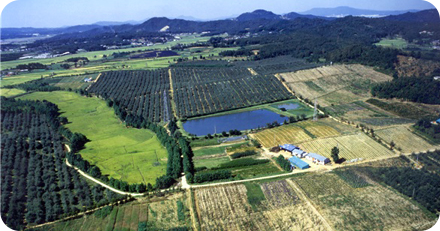
Fruit-growing
businessIn 1977, approx. 306,776m2 of land owned in the region of Jeongnam-Myeon, Hwaseong-Gun was reclaimed throughout 1980 to form the Waeseong Apple Tree Complex, boasting a significant size of 406,611m2 .
-
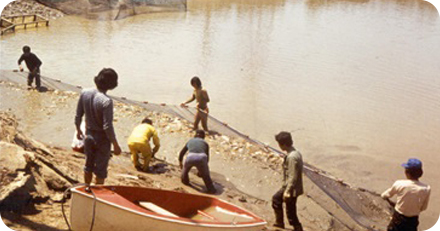
Fish
farmingThe reservoir that had been built to irrigate the Waeseong Apple Tree Complex and Orchard was converted into a fish farm, where 81,000 young carps were released and farmed until 1982. It was one of the largest fish farms in Korea at the time.
-
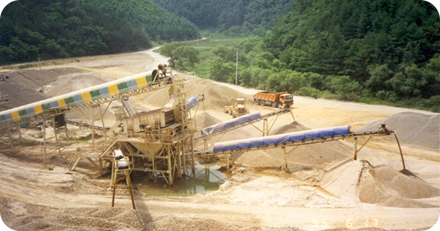
Aggregate
businessThe aggregate business was started to make the most of the forest resources owned by the company, tap unrealized revenue, and diversify the company’s business, re-investing its profits generated into building forest resources. The company engaged in the business from 1991 to 1998, during which its monthly production capacity reached 30,000㎥ in rubble and 47,000㎥ in combined rocks.
8.Expansion into other business areas
Since starting the afforestation business, which marked the very beginning of private-sector-led afforestation, the company entered the businesses of cultivating saplings, growing fruit trees, fish-farming and producing aggregate, but the profits from these businesses were too little to sufficiently fund the afforestation of 30,000 ha of land, which was the initial goal. As such, the company started to look into new business areas it could enter. Following thorough industry and market analysis as well as business planning, the company started a landscaping business in 1997 when the industry was still considered to be in its infancy but presented great growth potential.
9.Landscaping business
The first construction started as part of the landscaping business was for the Sheraton Walkerhill Hotel in 1978. Drawing on its experience of having planted and grown trees for many years, SK forest was able to complete the landscaping work in time for the official opening of Sheraton Walkerhill Hotel, confirming that SK forest had the potential to reap success in the field of landscaping. This was followed by the landscaping for Walkerhill Apartment in 1979. The Apartment was scheduled to be used as the temporary residence for athletes from over 70 countries coming to Seoul for the ISSF World Shooting Championships. With the successful completion of the project, SK came to be recognized for its competence in landscaping both from home and abroad.
During the 1980s, the company acquired several permits, aiming to be registered as an integrated landscaping and construction company. This helped SK forest to win a number of projects, including the landscaping for the second national government complex in Gwacheon, the landscaping for Suwon Sports Complex, the construction of Sunkyung Apartment in Daechi-dong, Olympic Apartment, Ulsan Technology Support Research Institute, and the landscaping of Olympic Citizens’ Hill. By carrying out projects for SK Group as well as for other clients, SK forest continued to affirm its position as a specialist in landscaping throughout the 1980s.
In 1989, with the acquisition of its permit as an integrated landscaping and construction company, SK forest saw a larger number of projects coming in during the 1990s, including construction projects for Korea National Housing Corporation, Korea Land and Housing Corporation, and Korea Electric Power Corporation, all of which are corporations funded by the Korean national government. Based on its ongoing success, SK forest saw an annual revenue of KRW 10 billion in 1995 and KRW 20 billion in 2001.
The company’s outstanding landscaping work was recognized with an award by the Seoul Metropolitan Government in 2000, followed by a presidential award in 2003 for the company’s ontribution to the nation’s landscaping industry. Ulsan Grand Park, which was built by SK Co. Ltd. and donated to the city of Ulsan in 2002, also won the President’s Award in the category of Landscape Planning of the IFLA Asia-Pac Landscape Architecture Awards held in September, 2009.
10.Another leap forward
Throughout its half-century history, SK forest has grown into a company that is not only conducting the business of afforestation, but also brings greater value to our daily lives through nature and forests.
The forests formed by SK forest have acquired the recognition of KFCC and are continuing sustainable management of the forest, offering a variety of benefits to the public through projects where social corporations are supported and training facilities are sponsored. This is specifically done by using the forest areas as shared infrastructure. In doing so, the company aims to realize co-prosperity of various stakeholders, including the many social corporations, local corporations, and residents. This is the company’s way of creating better social value through its forests.
In 2012, SK forest started A/R CDM Project in the national forests of Goseong, Gangwon-do. The following year in 2013, it received final approval for A/R CDM from the United Nations Framework Convention of Climate Change to become the first Korean corporation to have secured carbon emissions rights through afforestation projects.
In addition, by registering the plantation sites owned by the company in Chungju, Cheonan, Yeongdong and Hoengseong as 'Carbon Offset Projects,' SK forest is working toward building up carbon absorbents through afforestation.
Internationally, it has transferred technologies for afforestation and cultivation of saplings especially in areas that have suffered from desertification, including the Navoiy region of Uzbekistan, where an afforestation project was undertaken, Tunisia, where a cork and oak tree restoration project was carried out, and the province of Qu□ng Tr□ in Vietnam, where a rural community development initiative called the 'Happiness Program,' was launched. As ESG values take on greater importance in today’s business management, SK forest has been developing projects in various areas for its next leap forward, including projects for carbon emissions rights that would leverage the forests at home and abroad to fight climate change. The company remains committed to continuously transforming itself as an organization that further improves the quality of life for mankind through forests.



